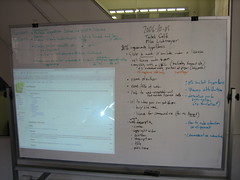licensing: Difference between revisions
m (entry-title, auto toc, put sub-areas into see also as well, link history) |
m (Replace <entry-title> with {{DISPLAYTITLE:}}) |
||
| (One intermediate revision by one other user not shown) | |||
| Line 1: | Line 1: | ||
{{DISPLAYTITLE:Licensing}} | |||
;shortlink | |||
:http://tr.im/uflcn | |||
This is a page for tracking the effort to develop means for authors and publishers to indicate licensing and attribution requirements about web pages and media (e.g. audio, video, images) that they create and publish, possibly within the context of a still in-development [[media-info]] microformat. | This is a page for tracking the effort to develop means for authors and publishers to indicate licensing and attribution requirements about web pages and media (e.g. audio, video, images) that they create and publish, possibly within the context of a still in-development [[media-info]] microformat. | ||
Latest revision as of 16:28, 18 July 2020
- shortlink
- http://tr.im/uflcn
This is a page for tracking the effort to develop means for authors and publishers to indicate licensing and attribution requirements about web pages and media (e.g. audio, video, images) that they create and publish, possibly within the context of a still in-development media-info microformat.
Per the microformats process:
- Start by gathering licensing-examples.
- Document existing licensing-formats standardization efforts.
- licensing-brainstorming
Introduction
 While rel-license has successfully allowed publishers to semantically express licenses to their web pages since first introduced in early 2004, the need to express licenses for external resources and portions of web pages, as well as the possibility of expressing attribution requirements (if any) motivate the exploration of a new licensing microformat.
While rel-license has successfully allowed publishers to semantically express licenses to their web pages since first introduced in early 2004, the need to express licenses for external resources and portions of web pages, as well as the possibility of expressing attribution requirements (if any) motivate the exploration of a new licensing microformat.
The licensing microformat explorations are based on a licensing microformat discussion on 2006-10-05 between Tantek Çelik (Technorati) and Mike Linksvayer (Creative Commons) with a focus on the attribution requirements of Creative Commons licenses. The whiteboard results of those discussions was captured in a photograph which is posted on Flickr.
Usecases hypothesis
Current usecases hypothesis:
- License that is used
- Human copyright owner expresses license
- Human viewer clearly understands what is the license being used
- Machine-precise reference to the license
- search engines discovering which license is used
- What is licensed (whole page, part of page, external resource etc.)
- Human copyright owner expresses what is licensed
- Human viewer clearly understands what is licensed
- Machine-precise semantic for what is licensed
- search engines discovering what is licensed
- How to attribute (if necessary)
- ability to generate attribution/reference
- Licensee (republisher or creator of derivative) expression of original's attribution and copyright notice requirements
- In the case of a derivative, also expression of all of the previous for the new work
80% requirements
- State a work (any copyrightable thing, i.e., a "fixed expression") is available under a license
- simple rel-license works for web pages
- anything with a URL (fragment IDs, embedded media)
- Name of author
- Name/title of work
- Link to copyright holder specified URL (attribution URL)
- URL where you can potentially get information on buying or commercially licensing the work
20% requirements
- Licensor waives attribution
- Credit identifying the use of the Work in the Derivative Work (e.g., "French translation of the Work by Original Author," or "Screenplay based on original Work by Original Author").
- How to make a donation related to the work.
See also
- licensing-examples
- licensing-formats
- licensing-brainstorming
- rel-license outside any other microformat denotes a license for a web page at that granularity.
- media-info is a likely candidate microformat for including licensing and attribution information.
- CC Attribution license section 4 lays out legal attribution requirements for users of CC licensed works.